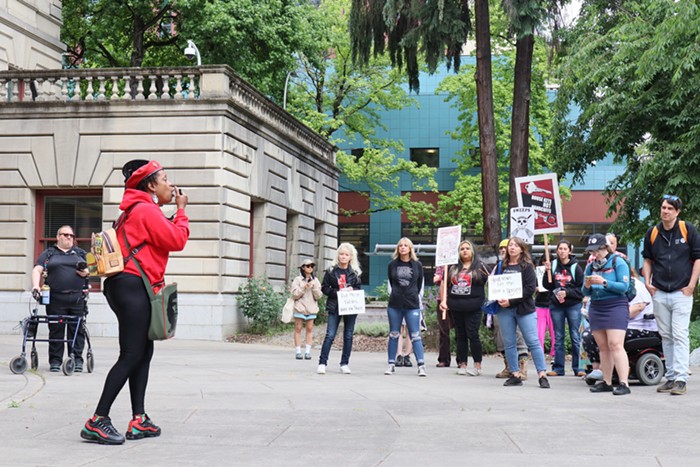
- Agathe Poupeney
- Arm swinging. Lots of arm swinging.
It can feel like there is a lot of pressure to understand and celebrate all the really unusual and challenging work presented at an art festival like TBA, especially as a reviewer. After all, it's very carefully curated, and many of the artists have won international awards for their work, so clearly there are many people understanding and appreciating what they're doing. But I can't speak for them, and in this case I have to admit that I did not get Nacera Belaza's Le Cri.
PICA Artistic Director Angela Mattox spoke briefly before the piece on Saturday, which was the second-to-last TBA:13 show at the Con-Way. She noted that for this year's festival, she was very interested in artists with "singular, uncompromising artistic vision," and when I think about that now, it seems equal parts introduction and disclaimer.
I have seen Belaza's choreography described as mesmerizing, spare, introspective, hypnotizing, minimal, and I certainly agree. But I would also add that this work—which from what I've read must have been quite similar to Le Trait and Le Temps Scelle, her other performance earlier in the week—was repetitive, impenetrable, imcomprehensible, and about 40% of the time, creepy.
Over the first 15-20 minutes, the lights, sound, and arm-swinging movement all went from zero to about 200, from dark to too bright, from quiet to too loud, from still to frantic, everything gradually increasing from slow to fast, from calm to overwhelming. And then it stopped, lights went out, the two dancers (Belaza and her sister) moved to a different part of the stage, planted their feet, and did it all again to a different soundtrack of dissonantly layered music and prayer chanting or children shrieking. But... why?
PICA's blog has an interview with Belaza in which she explains: "I started dance very early, at 7 or 8, in my room. When I started to dance, it was like when you start talking or singing or walking; you realize it’s a way to express yourself….But I was in a context that didn’t allow me to practice dance for many reasons, so I had to find a way. For example, in Le Cri…we are stuck in the same place onstage…digging inside of us, trying to find a very deep energy to throw out. This is how I did it in my life. I couldn’t go out, I couldn’t travel, I couldn’t explore, so I said, okay, I will dig inside of myself. It’s another way to find freedom."
This context does make some sense of the performance, but I did not find that interview until after I saw the performance, which at the time I found so puzzling and inexplicably creepy that I was actually a little angry about it. Setting aside my hunch that if I were a person with PTSD, this show would have triggered me like crazy (I'm not, but it nearly did anyway!), I think it's the introspective aspect that doesn't work for me. If you are so inwardly focused that the audience can't find a way in to what you're bringing them, then it can reach a point where it feels very one-sided, more like the artist is performing purely for their own experience of doing it. But how cathartic can it really feel if the viewers can't connect with the work?
I know that many people did enjoy and engage with Le Cri, and I certainly welcome their counterpoints in the comments.












